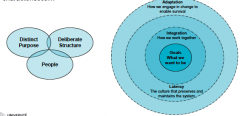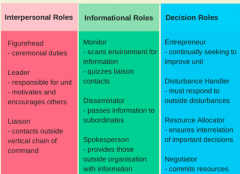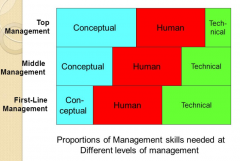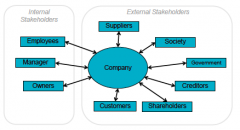![]()
![]()
![]()
Use LEFT and RIGHT arrow keys to navigate between flashcards;
Use UP and DOWN arrow keys to flip the card;
H to show hint;
A reads text to speech;
39 Cards in this Set
- Front
- Back
|
Manager |
Someone who coordinates and oversees the work of other people so organizational goals can be accomplished. |
|
|
First-line (frontline) managers |
Managers at the lowest level of management who manage the work of non-managerial employees. Examples: Supervisor, Shift Manager, District Manager, Department Manager, Office Manager. |
|
|
Middle Managers |
Managers between the lowest level and top levels of the organization who manage the work of first-line mangers. Regional manager, project leader, store manager, division manager. |
|
|
Top Managers |
Managers at or near the upper levels of the organization structure who are responsible for making organization-wide decisions and establishing the goals and plans that affect the entire organization. |
|
|
Organization : Definition, commonalities, and functional imperatives |

A deliberate arrangement of people to accomplish some specific purpose. Commonalities: They have a distinct purpose, a deliberate structure, and people. Functional Imperatives: Adaptation the ability to engage in change to enable survival Integration: Working together Goals Where we want to be Latency A culture that preserves and maintains the system |
|
|
Management |
The coordinating and overseeing of the work activities of others so their activities are completed efficiently and effectively. |
|
|
Efficiency |
When dealing with scarce resources, people, money and equipment, Efficiency is considered as doing things right, or getting the most output from the least amount of inputs. |
|
|
Effectiveness |
The ends, or attainment of organizational gaols. Doing the right things, or doing those work activities that will result in achieving goals. |
|
|
Planning |
Management function that involves setting goals, establishing strategies for achieving those goals, and developing plans to integrate and coordinate activities. |
|
|
Organizing |
Management function that involves arranging and structuring work to accomplish organization's goals. |
|
|
Leading |
Management function that involves working with and through people to accomplish organizational goals. |
|
|
Controlling |
Management function that involves monitoring, comparing, and correcting work performance. |
|
|
Mintzberg's Managerial Roles Model |

A model that shows what managers can do best by looking at their managerial roles they engage in at work. |
|
|
Managerial Roles |
Specific actions or behaviors expected of and exhibited by a manger |
|
|
Interpersonal Roles |
Managerial roles that involve people and other duties that are ceremonial and symbolic in nature. |
|
|
Informational roles |
Managerial roles that involve collecting, receiving, and disseminating information. |
|
|
Decisional roles |
Managerial roles that revolve around making choices |
|
|
Technical skills |

Job-specific knowledge and techniques needed to proficiently perform work tasks. |
|
|
Interpersonal Skills |
The ability to work well with other people individually and in a group |
|
|
Conceptual skills |
The ability to think and to conceptualize about abstract and complex situations. |
|
|
Important Managerial Skills |
- Managing Change -Using Purposeful networking -Managing logistics and technology -Managing strategy and innovation -Facilitating the psychological and social contexts of work -Inspiring commitment -Managing human capital Structuring work and getting things done -Managing decision-making processes |
|
|
Social Media |
Forms of electronic communication through which users create online communities to share ideas, information, personal messages, and other content. |
|
|
Sustainability |
A company's ability to achieve its business goals and increase long-term shareholder value by integrating economic, environmental, and social opportunities into its business organization. |
|
|
Universality of management |
The reality that management is needed in all types and sizes of organizations, at all organizational levels, in all organizational areas, and in organizations no matter where located. |
|
|
Invisible and Visible Characterization of an organization [IceBerg Image] |
Visible: Written rules, procedures, Organization structure [bureaucratic aspects] Invisible: Culture, Identity, Expectations, Attitude, Values, Processes, History, Challenges, Changes |
|
|
Stakeholders |

"Any group or individual who can affect or is affected by the achievement of the organization's objectives." --Freeman (1984) |
|
|
Division of Labor (Job specialization) |
The breakdown of jobs into narrow and repetitive tasks (Adam Smith, Pin example) |
|
|
Industrial Revolution |
A period during the late 18th century when machine power was substituted for human power, making it more economical to manufacture goods in factories than at home |
|
|
Classical Approach [to management] |
1911-1947; First studies of management, which emphasized rationality and making organizations and works as efficient as possible. Scientific management ( Father: Frederick Winslow Taylor Principles of Scientific Management and Frank & Lillian Gilbreth : Cheaper by the dozen) and General Administrative Theory (Henri Fayol and Max Weber) |
|
|
Scientific Management |
An approach that involves using the scientific method to find the "one best way" for a job to be done. Finding best qualified workers for a job, design incentive systems based on output. F.W. Taylor Pig iron experiment : putting pigs in a cart and collective tons. |
|
|
Therbligs |
Classification scheme for labeling basic hand motions (Scientific Management Movement) |
|
|
General administrative theory |
focuses on what managers do and what constitues good management practice. Henri Fayol "Planning, Organizing, Commanding, Coordinating, and Controlling" Fayol - all manager focus, where as Taylor - first-line manager focus |
|
|
Principles of Management |
Created by Fayol [14 principles that could be applied to all organizational situations and taught in schools. Division of Work [Specialization increases output by making employees more efficient], Authority [Managers must be able to give orders, and authority gives them this right] , Discipline [Employees respect and obey rules that govern the org], Unity of command [Employee receives orders from uniquely one superior], Unity of direction, Subordination of individual interests to the general interest, Remuneration, Centralization (degree in which subordinates are involved in decision making), Scalar chain (line of authority from top management to lowest ranks), Order (people and materials right place right time), Equity (managers fair to subordinates), Stability of tenure of personnel (management provides orderly personnel planning and ensures replacements for vacancies), Initiative (employees can originate and carry out plans), Esprit de corps [team spirit] |
|
|
Bureaucracy |
A form of organization characterized by division of labor, a clearly defined hierarchy, detailed rules and regulations, and impersonal relationships. Max Weber. Weber bureaucracy. |
|
|
Organizational behavior (OB) |
Behavioral Approach 1700-1950s Field of study that researches actions of people at work. OB research involves managers motivation, leading, building trust, working with a team, conflict management etc. |
|
|
Organization's Activities |
Support Activities (Firm Infrastructure, HR management, Technology Development, Procurement) + Primary Activities (Operations, Inbound/Outbound Logistics, Marketing & Sales, After Sales Service) creates Value: What buyers are willing to pay |
|
|
Organization's Structure |
Functions, Products, Customers, Geographies, Processes. |
|
|
Types of Organizations |
Business Enterprises, Political Organizations, Governmental Agencies, Supra-national organizations, Non-governmental organizations, Foundations, Clubs. Distinguished by their purpose, orientation, governance and structure, ownership, and management approach. |
|
|
System |
set of interrelated and interdependent parts arranged in a manner that produces a unified whole. |

